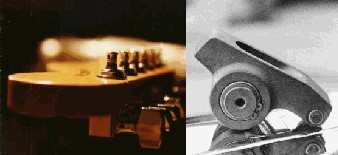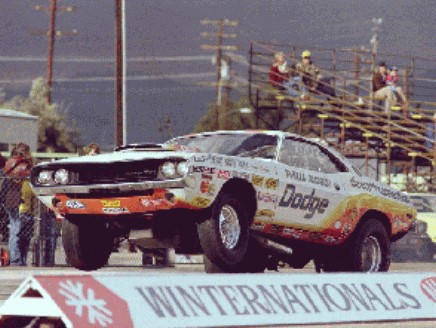



This is how Pro Stock and other classes are able to launch the car at over 10,000 R.P.M. and shift at even higher R.P.M.. Things start at the quarter mile drag strip and if they can last through a three or four day national event, they eventually end up in oval racing, road racing and someday on a new car at the dealer. Some new car engines have hydraulic roller lifters to reduce friction, oil temperatures, thus emissions, increase fuel economy and reduce the frequency of valve adjustment. The reason I suggest a mechanical solid lifter camshaft, if your engine can run one, and they are still available, is they are arguably more reliable and less expensive. Obviously new car makers can get roller lifter camshafts through the warranty period, but they increase the amount of parts that can fail. Regardless of the type of camshaft you use, you will need a double or triple valve spring to keep the valves from floating. Generally two coils or two coils and a flat wound dampener. Many aftermarket camshaft and kits come with aluminum valve spring retainers. If you can not avoid using aluminum retainers you should not reuse them when valve guides become worn or springs lose tension. For my money L88 valve springs with General Motors steel valve spring retainers get the job done without dropping a valve due to retainer failure. If your brand engine is stuck with aluminum retainers I would spend the money on titanium if no steel retainers are available that fit valve springs required to achieve your R.P.M. potential desired.
My recommendation is eleven to one compression, and given several choices of camshafts that are the biggest camshaft you can get that will fit in the engine without machining the pistons for valve clearance, buy the camshaft with the gentlest profile which is generically the one with the most duration if the valve lift specifications were all equal. So as an example, cam number one is two hundred and eighty degrees of duration at seven hundred lift. Cam number two is three hundred degrees of duration at seven hundred lift. Cam number three is three hundred and twenty degrees of duration at seven hundred lift. Buy the camshaft that takes the most time, in degrees of crankshaft rotation, to go from closed to maximum lift. This will add to your valve train longevity. If you cannot figure this out just “buy the biggest camshaft you can get that will fit in the engine without machining the pistons for valve clearance” and that would be example three. Unfortunately comparing camshafts can be difficult because the different manufacturers measure them differently. Some measure the duration when the valve opens one millimeter, others at eight thousandths of an inch, fifteen thousandths of an inch, or fifty thousandths of an inch at the lifter. That’s why I refer you to my now famous quote which you should have committed to memory.
I recommend an open plenum intake manifold with a single four barrel carburetor, whereby there is air space between the casting covering the engine valley, and the underside of the plenum, like an Edelbrock Victor or a Holley Strip Dominator style manifold. Check for under hood clearance. The air space is to lower the temperature of the fuel air mixture to increase charge density, by keeping the carburetor cooler. For every ten degrees cooler the incoming fuel air mixture is, there is a one percent increase in horsepower. If the engine makes seven hundred horsepower at one hundred degrees air intake temperature, it is going to make 735 horsepower at fifty degrees air intake temperature, which is why race cars have hood scoops pulling cool air into the engine from outside, not air heated by the engine drawn from under the hood.
For Chevrolet engines valve train, it is hard to beat Ed Isky forged Aluminum roller bearing rocker arms and a Jomar Stud Girdle. When I worked at S.C. Performance Wholesale I got box loads of other manufacturers broken aluminum rocker arms back. Just remember I did not recommend aluminum rocker arms as they are not created equal. I recommended Ed Isky forged Aluminum roller bearing rocker arms and a Jomar Stud Girdle. These are the only Aluminum internal engine parts I recommend for several reasons. Exhaust valves get extremely hot and aluminum dissipates heat. The rocker arms reduce friction, engine oil temperature, metal wear from depositing in the oil, and combined with the stud girdle increase rigidity, the accuracy of delivering full valve lift and duration, and reduce the frequency of valve adjustments required. Make sure you do not over rev your engine or float your valves and make sure your valve springs do not bind as there must be clearance at full lift. If you are running a Chrysler engine with shaft mounted rocker arms checkout forged steel rocker arms like Bruce Crower manufactures at Crower cams.
Light the candles. Let there be light. Lights, Camera, Ignition, Ready for lift off. Let’s talk triggers. Single point, Dual points, Optical and Magnetic trigger electronic distributor, Crank trigger. They all work. Points are museum items. General Motors chose Magnetic trigger electronic distributor. This is a good choice. The logic of using a distributor instead of crank trigger is that the camshaft is locked more closely to the ignition timing, during the miniscule deviations, due to timing chain stretch at high R.P.M.. The logic of using a Magnetic trigger electronic ignition distributor, is it’s fairly impervious to debris inside the distributor cap causing failures. What? Well, if you use the more accurate optical trigger, debris can theoretically foul the receiver. What’s that mean? Today’s electronic ignitions are high voltage. During operation the interaction between the rotor and the distributor cap electrodes is that of an arc welder, and thus, there, as time goes by, is a significant amount of conductive dust, and spatter in a virtual fog created as the rotor does it’s thing spinning around. Hot Rodders whom meticulously maintain their engines, just clean out their distributors with compressed air and whatever else works, to get all that metallic dust off everything in their distributor, so optical is good for us, like a Mallory Unilite. For the rest of society, whom view a tune up as a nauseating pain in the greenhouse gas, there is the Magnetic trigger electronic distributor. Not quite as accurate as the optical speed of light, but tough to beat for reliability. Either way, my advice is to carry an extra electronic module in the vehicle. Unlike God blessed stone age museum pieces called mechanical single or dual point distributors, electronic ignitions give you no warning whatsoever when they fail, it’s just lights out, as Archie Bunker use to say, Good Night Irene. Points wear and gradually performance becomes worse, until the engine misfires. Electronic ignitions can just stop, any where, at any time, instantly. Regardless of what you are Hot Rodding and what kind of trigger you choose, I recommend a Multiple Spark Discharge ignition system. This is a patented technological masterpiece, that works in addition to your distributor, and fires each spark plug as many times as it can, every time the piston comes up on the compression stroke. Arbitrarily at idle this might be dozens of times like a flamethrower, which is fabulously amazing for an engine with a big cam and a nasty rough idle. In the old days before M.S.D. you had to change your spark plugs constantly, they would foul all the time, regularly like clockwork. With M.S.D., you can buy a set of Robert Bosch Platinum spark plugs and they can last the life of the engine. Seriously, buy an M.S.D. unit and you will be thrilled. Since it takes X many nanoseconds to cycle a single spark, as engine R.P.M. increases, there is less time for the M.S.D. to throw sparks across the spark plug gap, so at high R.P.M., the M.S.D. may only be able light the plug three or four times. I don’t include all their exact scientific data, which is always being improved, because all you have to know is, without an M.S.D. you need a case of spark plugs. and that’s how great M.S.D. is. Newcomers to Hot Rodding will never get the thrill of going from points to a high voltage Mallory Unilite and an M.S.D.. It was a paradigm shift. It goes like this. With points it was an achievement to get an engine to rev to 6000 R.P.M. without misfiring, and the spark plugs would foul often and have to be changed. With a high voltage Mallory Unilite optical electronic distributor and an M.S.D. ignition, I used one cheap set of spark plugs to establish the fuel air mixture, which were removed and replaced, with a set of Robert Bosch Platinum spark plugs that lasted the life of the engine. The difference was mind boggling. It was unbelievable at first. It took a while to get use to. Watching the tachometer 6500, 7500, 8500 no problem, every time. These kinds of R.P.M. were something you only read about, and now were available reliably. This is no joke. Factory Chevrolet Road Racing Teams at one time made maximum horsepower at 5800 R.P.M..

